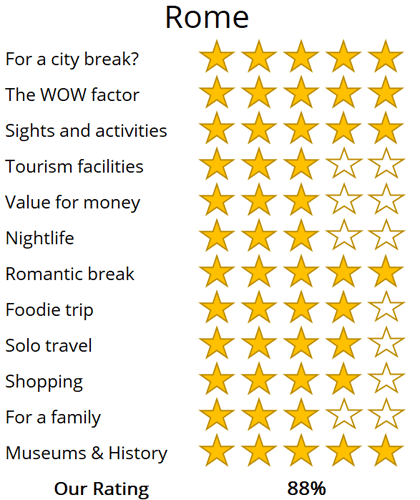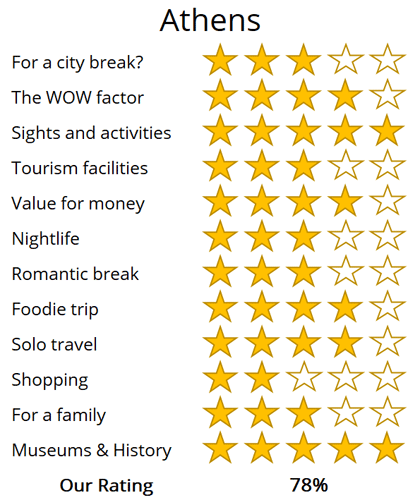WhereToGoForMyHoliday.com
The best destination comparison site!
WhereToGoForMyHoliday.com
The best destination comparison site!
Athens or Rome, which is better for your holiday in 2024?
Athens and Rome both offer unique and enticing experiences, but which one should you choose for your city break or holiday?
We recognise the difficulty in making this decision. While there is abundant information available on both destinations, clear guidance on which city better aligns with your travel preferences is often hard to find.
This article aims to provide an impartial comparison of Rome and Athens, and hopefully help you to choose the best city to visit.
The article is structured into several sections, each of which can be directly accessed through the following links:
• Introduction to the cities
• Scores and ratings
• Which one should I, friends, or family visit?
• When to visit and weather
• Who is the city suited for?
• The perfect 48hours (with map)
• Tourism details (where to stay? airport details?)
Introduction to Rome and Athens
No city can rival Rome’s historic and religious importance. The city is a living museum, with iconic landmarks and monuments, all intern-connected by grand avenues and charming side streets.
It maybe historical, but is far from a stagnant relic, Rome is a vivacious and chaotic city, led by emotions and the heart. Delicious food, late nights and socialising are the priorities for Rome, and keep the eternal city as one of Europe’s most popular cities.
There are flaws to Rome, often the result of political mismanagement, but gloss over these you will adore your time in Rome.
Athens, a city where antiquity meets modernity, invites travellers to embark on a journey through time. The Greek capital, steeped in history, proudly displays its ancient treasures while embracing the vibrancy of contemporary life.
The Acropolis stands as a monumental testament to Athens' glorious past, offering awe-inspiring views and a palpable connection to the city’s ancestors. Down below, lively neighbourhoods and trendy cafes showcase the modern Athenian spirit.
Whether indulging in delectable Mediterranean cuisine, exploring historic ruins, or wandering through charming streets, visitors are sure to be captivated. Athens is not just a destination; it’s an invitation to adventure, a place where the past and present dance together in harmonious splendour.

The Acropolis stands high above Athens
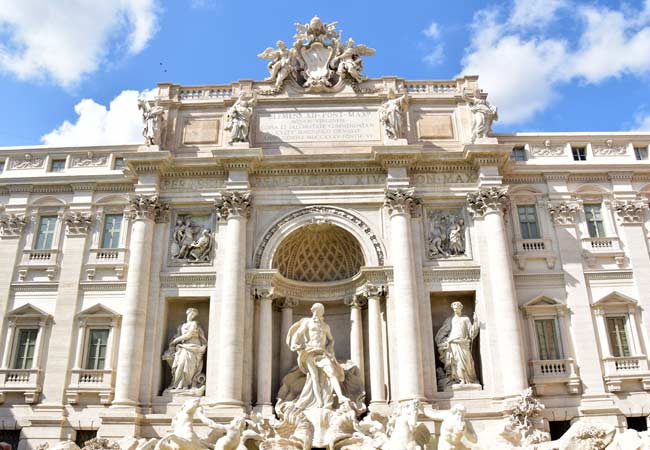
The Trevi Fountain, Rome
High-level summary for Athens and Rome
Summary
Where would I journey for a personal escape?
Rome
Where would I send my parents for a memorable visit?
Rome
Where's the ideal destination for my adventurous 19-year-old cousin?
Rome
Where should my food-obsessed friend indulge their culinary passions?
Rome
Note: The above comparisons are weather-independent and are based on travel during the most opportune times of the year. Details about the ideal travel seasons are elaborated upon later in this article.
In the sections that follow, you'll find a comprehensive comparison between these two fascinating cities. This includes recommendations on the duration of stay, the best times to visit, and tailored 48-hour itineraries for each city.
The final segment delves into practicalities for your travels, such as the best airport to fly into, the optimal districts for your accommodation, and insider tips, for when you come to explore the city.
We hope that you find all of this information useful, in planning your next exciting trip!
Destination details
How long to spend each city?
Considering the sheer number of outstanding tourist attractions, Rome can be seen within two days. Three days allows for a more enjoyable visit to Rome, with time to absorb the culture. There can be long queues for the Sistine Chapel and the Colosseum, so starting early in the day is essential for a two-day visit.
There are good day trips from Rome including the Roman ruins of Ostia Antica or the historic town Tivoli. Rome has excellent intercity trains, and it is possible to visit Florence or Naples, or even Pompeii (2 hours by train) as day trips.
Athens can be sampledin a few days, but it can also warrant trips of a few weeks or more. It all really depends on what you want out of your visit. If it's a whirlwind tour of the famous 5th-century history sights (the Acropolis, the Parthenon, the Agora), some Greek mezze, and a good night out that takes your fancy, then a weekend could be enough.
If you want to feel like a real local, sip gritty Greek coffees in corner bars in alt neighborhoods, and even escape to the islands to top up the tan, you'll need to plan longer.

The National Archaeological Museum, houses the world’s finest collection of Greek artefacts
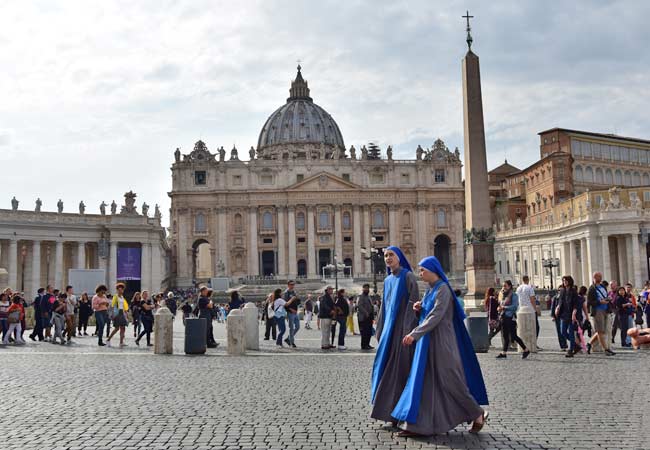
The Vatican is a city state within Rome
Most visitors head to Rome in the hot, humid and crowded summer months of July and August. Early spring or autumn are a much better time of year, and provides a much more agreeable climate, without the throngs of tourists.
To truly avoid the crowds, consider November to March, but there is always the slight chance of rain and it can be chilly. Even if it does rain, head indoors for a long lunch.
Athens is most popular in the summer months, but we'd say it's not the best time of year to come. Temperatures in Greece can be scorching between June and August, with daily highs peaking around the 40 Celsius mark!
Much better are the shoulder seasons of spring and autumn. These see warm days and cool evenings of between 16-29 degrees on average. It's still usually dry, with the occasional cloud and rainfall. However, there are also fewer people around, cheaper hotels, and smaller queues for the ancient ruins.
Winter in Athens gets surprisingly cold. Snow can even fall in the height of the season. It's the best if you really don't like dodging other tourists though, with the museums and the galleries all virtually empty. Be warned that ferries to nearby islands like Poros and Aegina rarely run between November and March.
The history lover is the traveller who will surely feel most at home in Athens. After all, this is the place of the mighty Parthenon; where the Athenian Empire once flourished. And it's got Orthodox temples and some of the most acclaimed ancient artifact museums on the globe to top the lot off. You can spend whole trips hopping between crumbling temples and learning about the hard-fought Peloponnesian War, without even scratching the surface of the amazing daytrip possibilities.
Aside from its famous historical relics, Athens also has a reputation for hedonism. Districts like anarchist Exarcheia come laced with squat bars and buzzy pubs. There's also pumping nightlife around the Plaka area, where you'll be able to dine on endless platters of saganaki cheese, hummus, and grilled lamb before heading out to dance the Zorba.
If you're planning a Greek beach holiday, then Athens is a good arrival point. You're likely to be a little disappointed if you hang around too long, though. The only sands within reach of the centre are in Vouliagmeni to the south and they certainly aren't the best in the country.
Rome’s appeal is ageless and timeless. It is no matter if you are going there for the perfect Instagram post of the Colosseum or on a religious pilgrim to the Vatican, the city will not disappoint.
Sadly, the years of austerity and political mismanagement are starting to wear through Rome, with an unkept and unloved mentality decaying around the edges of the city.
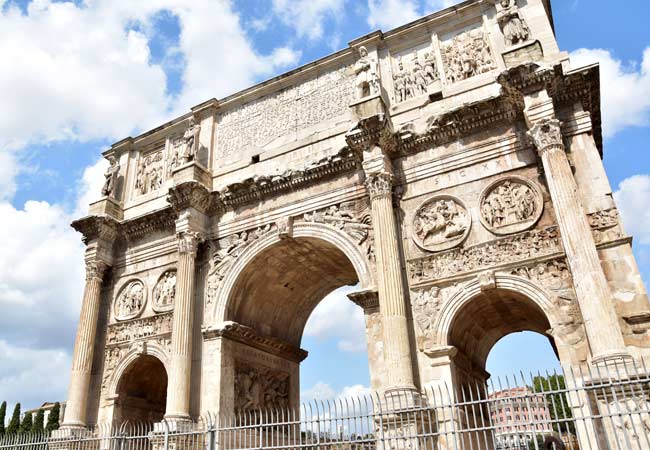
The Arco di Costantino, Rome

The delightful Pláka district, is a maze of narrow streets on the northern slopes of the Acropolis
Rome in 48 hours
Below is an interactive map for 48 hours in Rome; day 1 is highlighted in green and day 2 in yellow, with optional sights in grey.
Begin at the icon of Rome, the Colosseum, but also explore the Foro Romano with its many excellent Roman ruins. On the way to the historic centre of Rome passes the Vittorio Emanuele II Monument, with its amazing viewpoint.
For the afternoon explore the charismatic centre of Rome, taking in the Piazza Navona, the Fontana di Trevi and Piazza Colonna and the Pantheon.
For the evening head to the Trastevere district on the western banks of the Tiber, for bars, late food and lively experience.
Start early on the second day to avoid the queues for the Sistine Chapel and Saint Paul’s Basilica. From the Vatican City, follow the River Tiber past the Castel Sant'Angelo, Mausoleo di Augusto to the Piazza del Popolo.
For the afternoon explore the Villa Borghese park, before heading down the Via del Babuino, past the Spanish steps and into the Trevi district for a delicious meal. Before finishing in Rome part take in the tradition of passeggiata, an evening stroll wearing your finest clothes.
48hours in Athens
Searching for an all-round fantastic 48 hours in the Greek capital? Look no further. This culture-packed and monument-filled itinerary whizzes you through all the mainstay sights and even into some downright gritty local districts. Enjoy…
Day 1: Start as early as you can and head straight through the Plaka area up to the base of the Acropolis. The best way to reach that grand monument is via the winding roads that link up the tavernas with the great Propylaea gatehouse that dates to 437 BC. It was commissioned by Perikles in the aftermath of the Persian War and leads to the symbolic heart of ancient Athens: The Parthenon.
Getting there early means you can hopefully dodge the crowds and the heat. Take some time to wander to see the hulking columns and design – it's considered to be the finest Doric temple on the planet. The next-door Erechtheion also catches the eye. It was built after 421 BC in honour of Poseidon and Athena, famed for its Caryatid statues of female figures. A lookout point on the south-east end of the Acropolis is perfect for taking in the city views.
For lunch, go for the vibrant area of Koukaki, checking out the Theatre of Dionysus en route. It's filled with hip cafeterias and bakeries, all huddled under plane trees and bougainvillea. It's a short walk from there to the acclaimed Acropolis Museum. You can while away the whole afternoon within, uncovering the story of the legendary building and the politics it represented.
Think about ending the day with a walk through the pine trees to Filopappou Hill. That's home to the place where Socrates was imprisoned in the early 390s BC and tops out with some of the most stunning views of the Acropolis there are.

The Parthenon was dedicated to the Greek goddess Athena, who is regarded as the patron of the city
Day 2: The café culture of Monastiraki gets the day rolling – think about grabbing a traditional Greek coffee and pastry in one of the local bakehouses. A quick stroll through the blocks southwards then takes you to the Agora.
That was the epicentre of life in the ancient city state, complete with shrines and marketplaces and statues. The piece de resistance is the Temple of Hephaestus, which crowns a hillside on its northern end. Nearby, the blocks of Syntagma and Syntagma Square offer a glimpse at the modern edge of the Greek capital.
The vast plaza at the area's heart hosts the Old Royal Palace of the Greek monarchy. There are also countless places to sit with a cold lunchtime beer. Finished? Go south and you'll find the mighty Temple of Olympian Zeus. It is half ruined but still draws a gasp from most visitors on account of its monstrous Corinthian columns.
In the afternoon, catch a tram towards the National Archaeological Museum. Inside, you'll discover perhaps the richest collection of ancient artifacts there are in the world.
What's more, the district on the doorstep is Exarcheia. Be careful with your valuables in those parts, because it's rough and gritty, but the streets ooze character and have perhaps the most hedonistic bars in the country.

The Old Parliament House served as the parliament building until 1935
Traveling from Athens airport is best done using the metro. Line 3 links directly to the terminal. The fare is a flat €10 and the journey takes around 40 minutes each way. If leaving the city, be sure to catch the right train, because not all departures on the line go to the same place.
There are some areas that really stand out from the crowd when it comes to finding hotels in Athens. The Plaka is popular for its traditional Greek restaurants and proximity to the ancient sites.
Kolonaki has lots of chain hotels with rooftop pools and breakfast terraces. But Koukaki is also worth considering, for its local vibes and charming B&Bs.

The Theatre of Dionysus
Always beware of pickpockets, muggers, thieves and scams in Athens. The capital is generally safe, but certain areas – the Plaka, Omonoia Square and Exarcheia especially – do see regular crimes against tourists. Try to keep a hand on your wallet and an eye on your bag at all times.
Political upheavals in Athens are a common problem. Widespread discontent with the government has led to regular protests and marches since the 2000s. They can sometimes bring the whole city to a standstill and are worth avoiding – teargas, clashes with police and even Molotov cocktails have been known to play a part.
Getting around Athens is relatively easy. You've got a metro network that links most of the main tourist areas and the airport. Above ground, there are buses and trams going out to lesser known neighborhoods. There are both kiosks and vending machines at the entrance to most stations for you to buy tickets. They cost €1.40 and are valid for 90 minutes from the moment of validation.
Rome has to be visited at least once in your life and a city break is the ideal opportunity. Rome is served by two airports; Leonardo da Vinci (regular airlines) and Ciampino (low-cost airline), and there are regular train services from both to central Rome. There is plenty of flight capacity and reasonable prices can be found year-round.
Roman has numerous hotels, and accommodation options, but the common complaint is the relaxed approach to maintenance and upkeep. Rome is a destination to check all hotel/room reviews before booking.
For your first visit, you would want to be based in the tourist square, with Villa Borghese park in the north, Termini train station to the east, the Colosseum to the south and Vatican City to the west. Rome is an enjoyable and easy city to explore, and all of the main attractions are in this tourist square.
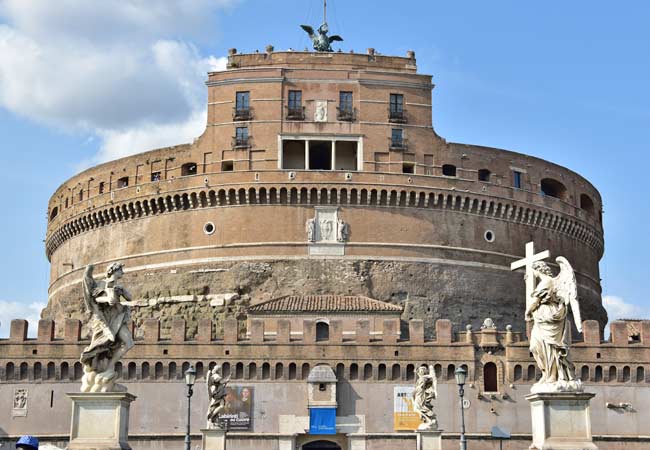
Castel Sant'Angelo, Rome

oh we were stuck in the airport!

Copenhagen was a bit expensive...

All we did was drink beer in Brussels...

Muncih was crazy

And we got so burnt!

Remeber that night in Rome

oh we were stuck in the airport

So much fun kayaking

Berlin and that group from Austria!

There was such a view from that church

And we got so burnt!

Munich was eventful, wasn't it!

Such a view from that cathedral in Florence

Lisbon was such so much fun

Last summer was so much fun .... x

Remeber that night in Rome

Lisbon was such so much fun

Such a view from that cathedral in Florence

Munich was eventful, wasn't it!

And we got so burnt!

Remeber that night in Rome

All we did was drink beer in Brussels...

Berlin and that group from Austria!

Can't wait to go back to Dubrovnik

Remember that boat ride in Prague

Copenhagen was a bit expensive...
